University Economics Homework: Scarcity, Demand, Supply, Pricing
VerifiedAdded on 2020/03/04
|10
|1776
|44
Homework Assignment
AI Summary
This economics homework assignment analyzes core economic principles including scarcity, demand and supply dynamics, pricing mechanisms, and production costs. The assignment begins with an exploration of the production possibility curve and opportunity costs, followed by an examination of scarcity's impact on individual and national economies. The solution then delves into demand and supply equilibrium, consumer and producer surplus, and the effects of price floors. Elasticity of demand is calculated and applied to real-world scenarios, alongside a detailed cost analysis for a gardening company, determining profit maximization based on marginal revenue and cost. The assignment utilizes diagrams, calculations, and real-world examples to illustrate key economic concepts. This assignment is a comprehensive exploration of microeconomic principles, offering insights into market dynamics and firm decision-making.
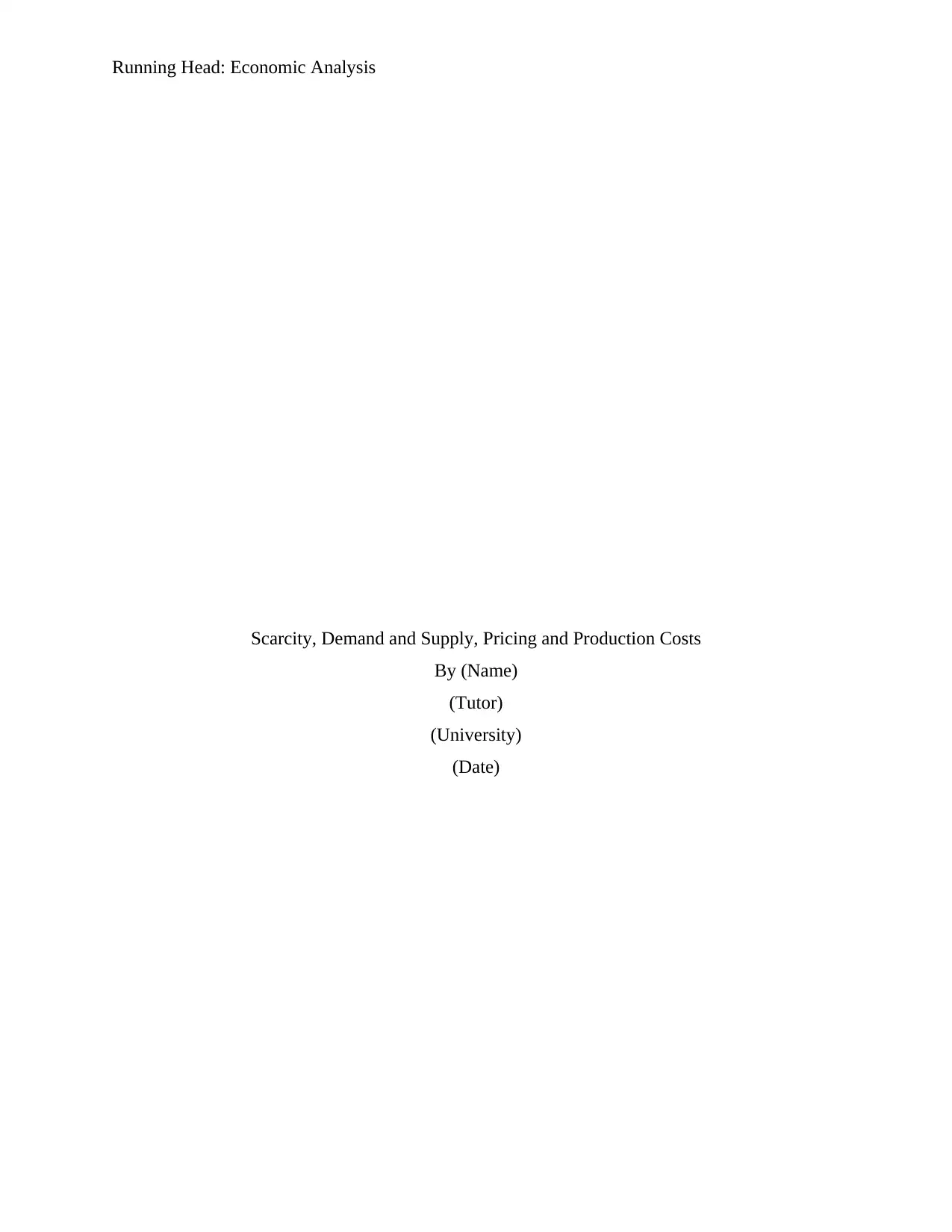
Running Head: Economic Analysis
Scarcity, Demand and Supply, Pricing and Production Costs
By (Name)
(Tutor)
(University)
(Date)
Scarcity, Demand and Supply, Pricing and Production Costs
By (Name)
(Tutor)
(University)
(Date)
Paraphrase This Document
Need a fresh take? Get an instant paraphrase of this document with our AI Paraphraser
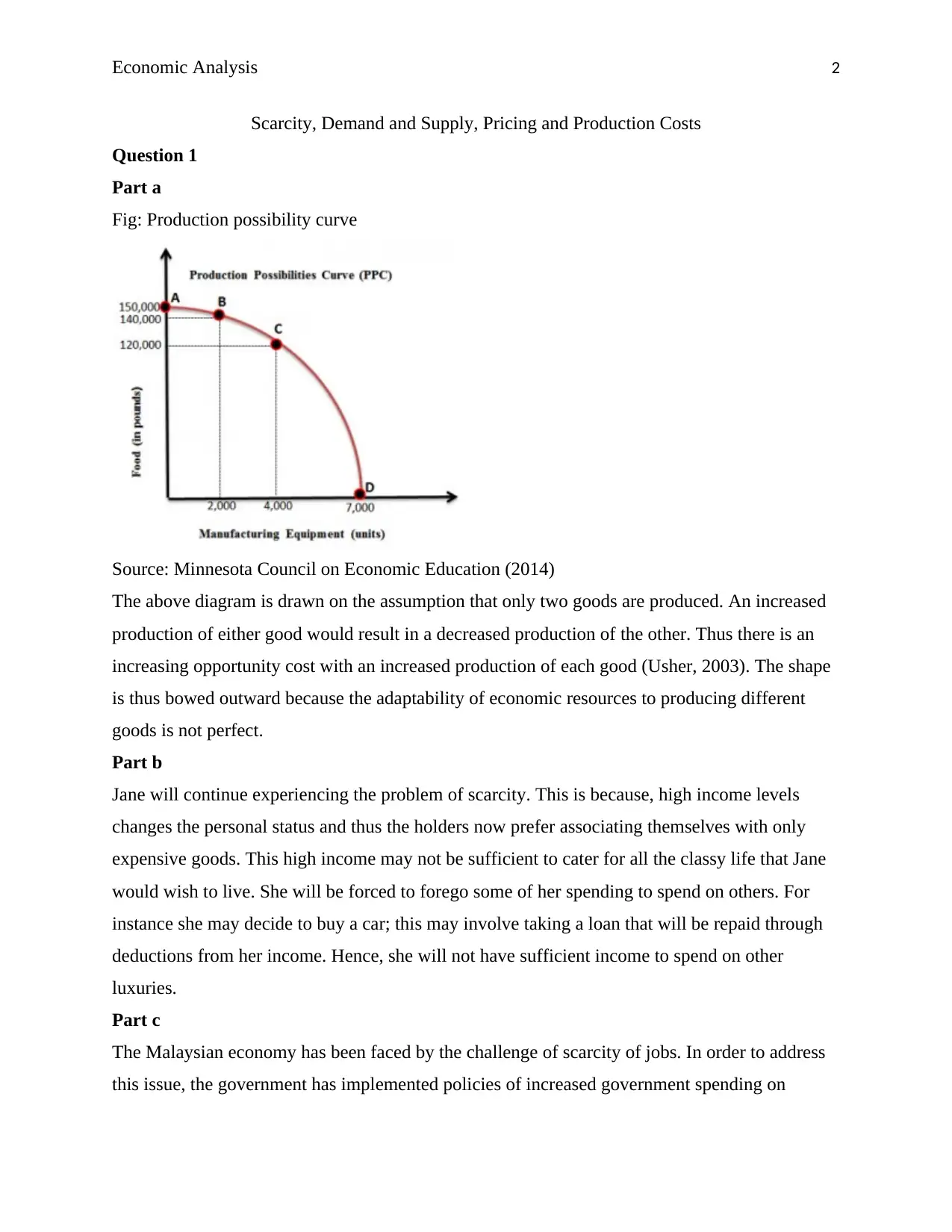
Economic Analysis 2
Scarcity, Demand and Supply, Pricing and Production Costs
Question 1
Part a
Fig: Production possibility curve
Source: Minnesota Council on Economic Education (2014)
The above diagram is drawn on the assumption that only two goods are produced. An increased
production of either good would result in a decreased production of the other. Thus there is an
increasing opportunity cost with an increased production of each good (Usher, 2003). The shape
is thus bowed outward because the adaptability of economic resources to producing different
goods is not perfect.
Part b
Jane will continue experiencing the problem of scarcity. This is because, high income levels
changes the personal status and thus the holders now prefer associating themselves with only
expensive goods. This high income may not be sufficient to cater for all the classy life that Jane
would wish to live. She will be forced to forego some of her spending to spend on others. For
instance she may decide to buy a car; this may involve taking a loan that will be repaid through
deductions from her income. Hence, she will not have sufficient income to spend on other
luxuries.
Part c
The Malaysian economy has been faced by the challenge of scarcity of jobs. In order to address
this issue, the government has implemented policies of increased government spending on
Scarcity, Demand and Supply, Pricing and Production Costs
Question 1
Part a
Fig: Production possibility curve
Source: Minnesota Council on Economic Education (2014)
The above diagram is drawn on the assumption that only two goods are produced. An increased
production of either good would result in a decreased production of the other. Thus there is an
increasing opportunity cost with an increased production of each good (Usher, 2003). The shape
is thus bowed outward because the adaptability of economic resources to producing different
goods is not perfect.
Part b
Jane will continue experiencing the problem of scarcity. This is because, high income levels
changes the personal status and thus the holders now prefer associating themselves with only
expensive goods. This high income may not be sufficient to cater for all the classy life that Jane
would wish to live. She will be forced to forego some of her spending to spend on others. For
instance she may decide to buy a car; this may involve taking a loan that will be repaid through
deductions from her income. Hence, she will not have sufficient income to spend on other
luxuries.
Part c
The Malaysian economy has been faced by the challenge of scarcity of jobs. In order to address
this issue, the government has implemented policies of increased government spending on
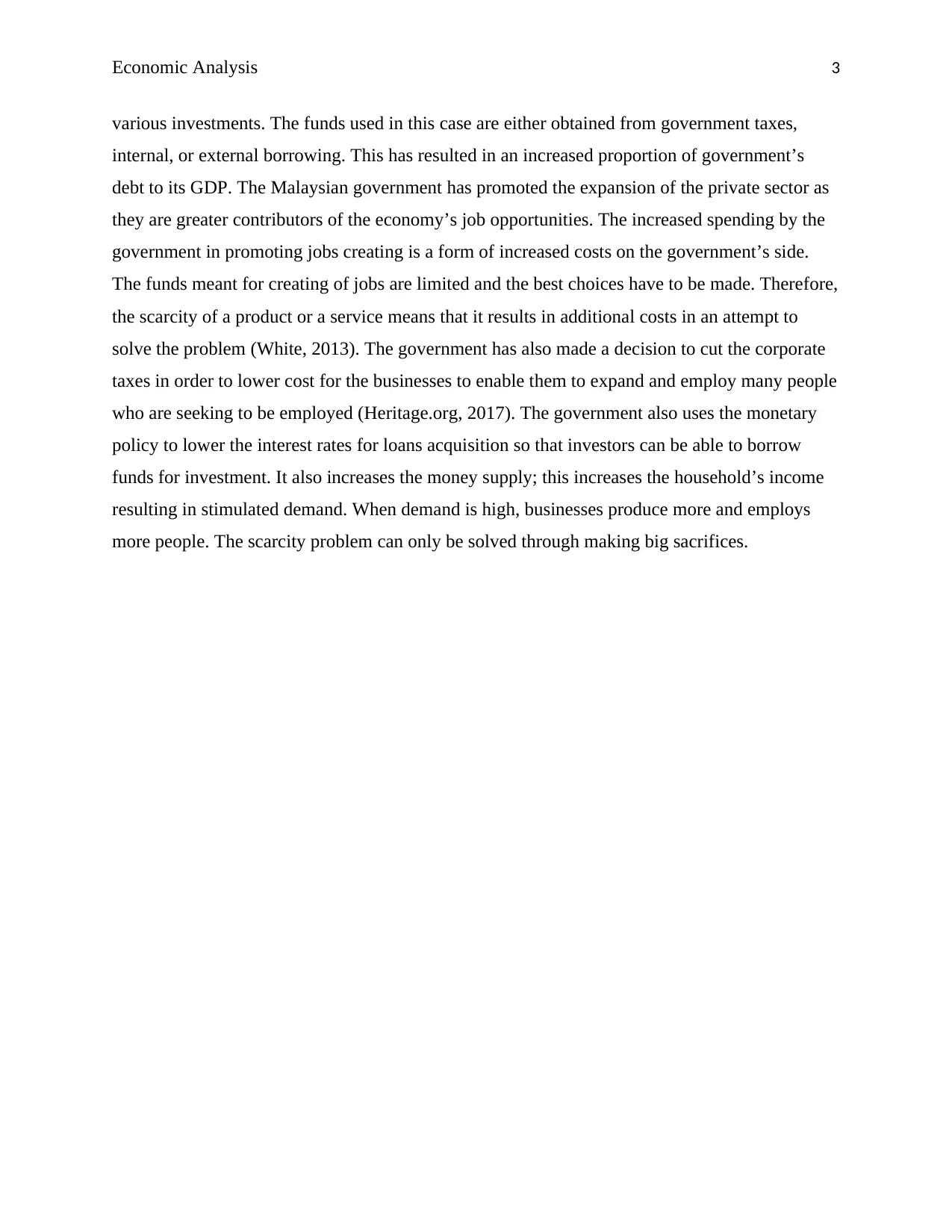
Economic Analysis 3
various investments. The funds used in this case are either obtained from government taxes,
internal, or external borrowing. This has resulted in an increased proportion of government’s
debt to its GDP. The Malaysian government has promoted the expansion of the private sector as
they are greater contributors of the economy’s job opportunities. The increased spending by the
government in promoting jobs creating is a form of increased costs on the government’s side.
The funds meant for creating of jobs are limited and the best choices have to be made. Therefore,
the scarcity of a product or a service means that it results in additional costs in an attempt to
solve the problem (White, 2013). The government has also made a decision to cut the corporate
taxes in order to lower cost for the businesses to enable them to expand and employ many people
who are seeking to be employed (Heritage.org, 2017). The government also uses the monetary
policy to lower the interest rates for loans acquisition so that investors can be able to borrow
funds for investment. It also increases the money supply; this increases the household’s income
resulting in stimulated demand. When demand is high, businesses produce more and employs
more people. The scarcity problem can only be solved through making big sacrifices.
various investments. The funds used in this case are either obtained from government taxes,
internal, or external borrowing. This has resulted in an increased proportion of government’s
debt to its GDP. The Malaysian government has promoted the expansion of the private sector as
they are greater contributors of the economy’s job opportunities. The increased spending by the
government in promoting jobs creating is a form of increased costs on the government’s side.
The funds meant for creating of jobs are limited and the best choices have to be made. Therefore,
the scarcity of a product or a service means that it results in additional costs in an attempt to
solve the problem (White, 2013). The government has also made a decision to cut the corporate
taxes in order to lower cost for the businesses to enable them to expand and employ many people
who are seeking to be employed (Heritage.org, 2017). The government also uses the monetary
policy to lower the interest rates for loans acquisition so that investors can be able to borrow
funds for investment. It also increases the money supply; this increases the household’s income
resulting in stimulated demand. When demand is high, businesses produce more and employs
more people. The scarcity problem can only be solved through making big sacrifices.
⊘ This is a preview!⊘
Do you want full access?
Subscribe today to unlock all pages.

Trusted by 1+ million students worldwide
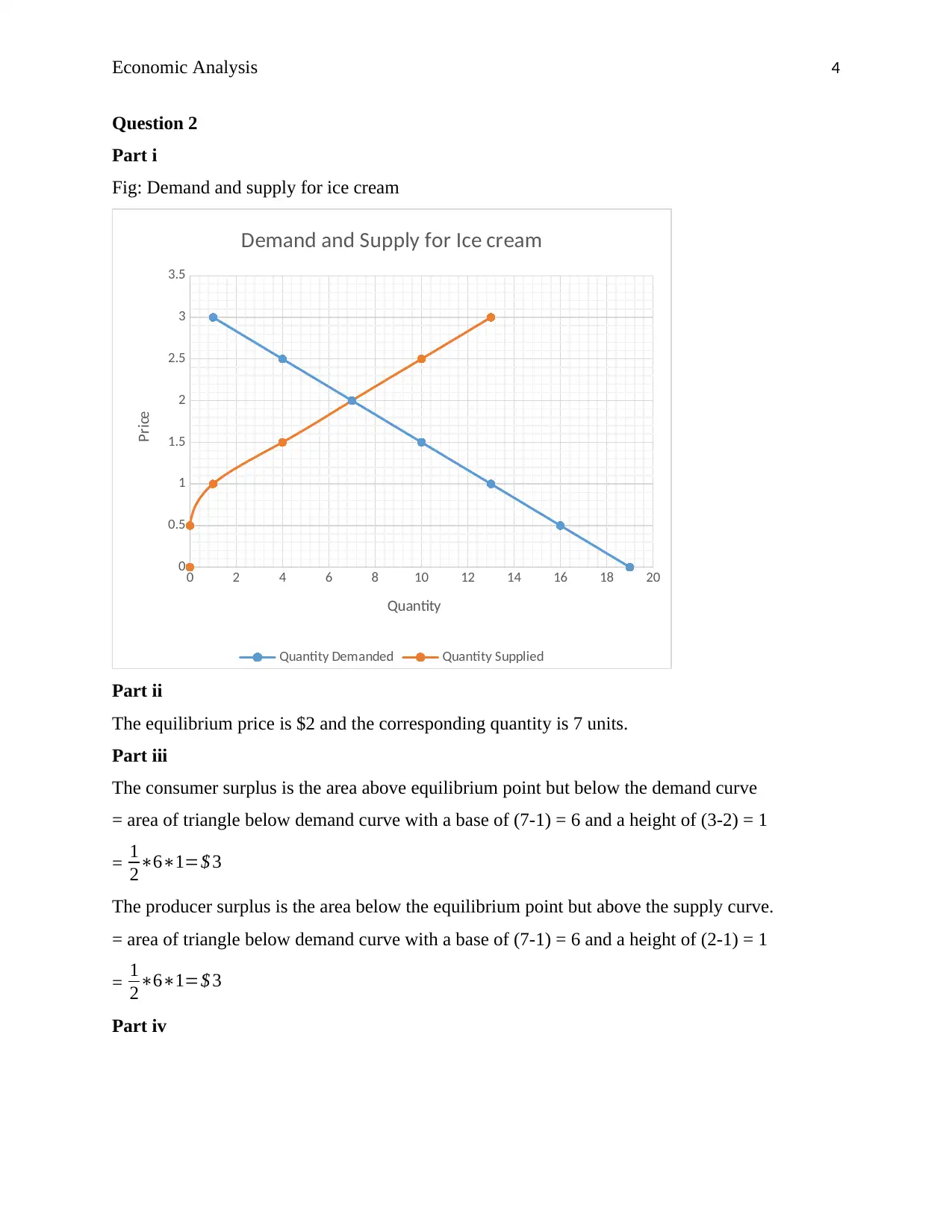
Economic Analysis 4
Question 2
Part i
Fig: Demand and supply for ice cream
0 2 4 6 8 10 12 14 16 18 20
0
0.5
1
1.5
2
2.5
3
3.5
Demand and Supply for Ice cream
Quantity Demanded Quantity Supplied
Quantity
Price
Part ii
The equilibrium price is $2 and the corresponding quantity is 7 units.
Part iii
The consumer surplus is the area above equilibrium point but below the demand curve
= area of triangle below demand curve with a base of (7-1) = 6 and a height of (3-2) = 1
= 1
2∗6∗1=$ 3
The producer surplus is the area below the equilibrium point but above the supply curve.
= area of triangle below demand curve with a base of (7-1) = 6 and a height of (2-1) = 1
= 1
2∗6∗1=$ 3
Part iv
Question 2
Part i
Fig: Demand and supply for ice cream
0 2 4 6 8 10 12 14 16 18 20
0
0.5
1
1.5
2
2.5
3
3.5
Demand and Supply for Ice cream
Quantity Demanded Quantity Supplied
Quantity
Price
Part ii
The equilibrium price is $2 and the corresponding quantity is 7 units.
Part iii
The consumer surplus is the area above equilibrium point but below the demand curve
= area of triangle below demand curve with a base of (7-1) = 6 and a height of (3-2) = 1
= 1
2∗6∗1=$ 3
The producer surplus is the area below the equilibrium point but above the supply curve.
= area of triangle below demand curve with a base of (7-1) = 6 and a height of (2-1) = 1
= 1
2∗6∗1=$ 3
Part iv
Paraphrase This Document
Need a fresh take? Get an instant paraphrase of this document with our AI Paraphraser
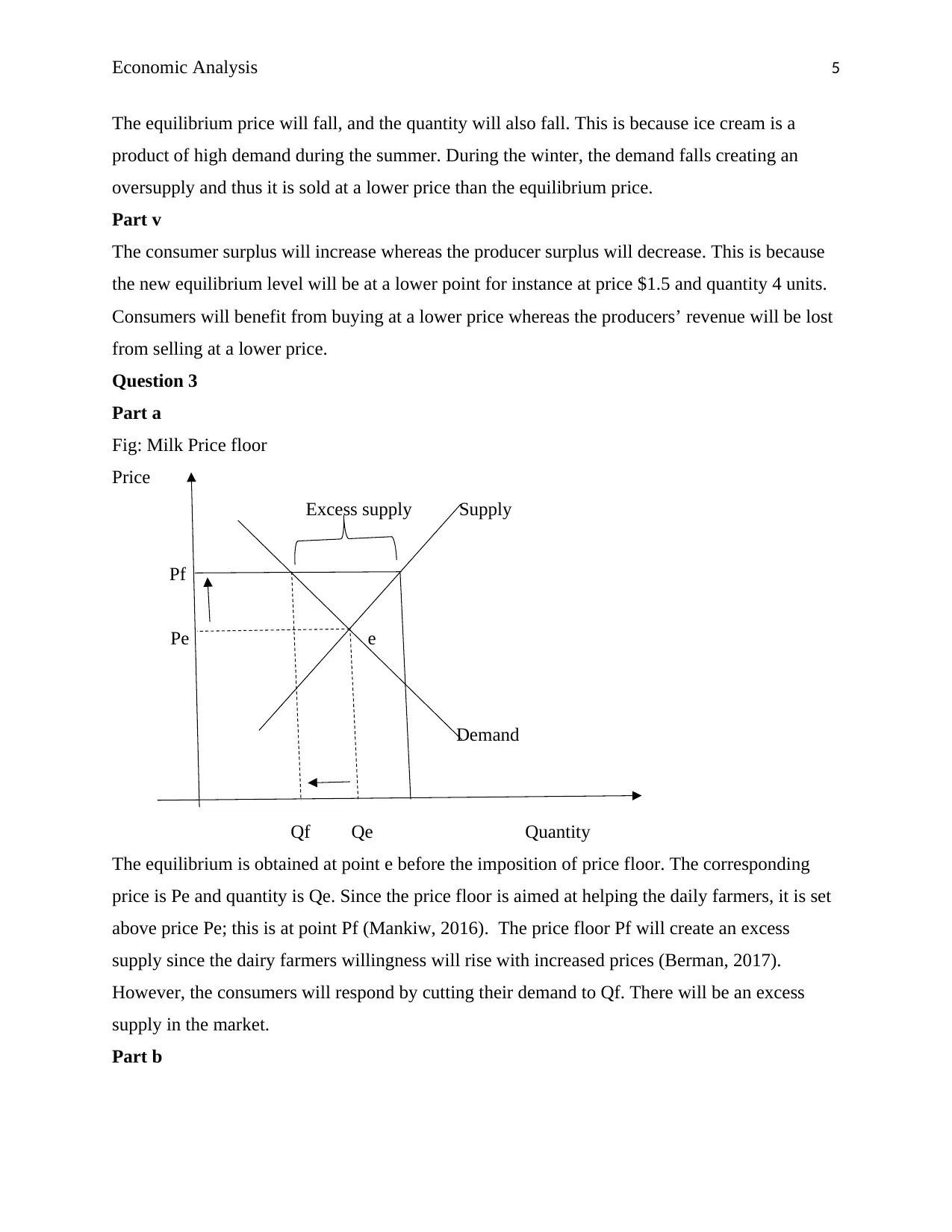
Economic Analysis 5
The equilibrium price will fall, and the quantity will also fall. This is because ice cream is a
product of high demand during the summer. During the winter, the demand falls creating an
oversupply and thus it is sold at a lower price than the equilibrium price.
Part v
The consumer surplus will increase whereas the producer surplus will decrease. This is because
the new equilibrium level will be at a lower point for instance at price $1.5 and quantity 4 units.
Consumers will benefit from buying at a lower price whereas the producers’ revenue will be lost
from selling at a lower price.
Question 3
Part a
Fig: Milk Price floor
Price
Excess supply Supply
Pf
Pe e
Demand
Qf Qe Quantity
The equilibrium is obtained at point e before the imposition of price floor. The corresponding
price is Pe and quantity is Qe. Since the price floor is aimed at helping the daily farmers, it is set
above price Pe; this is at point Pf (Mankiw, 2016). The price floor Pf will create an excess
supply since the dairy farmers willingness will rise with increased prices (Berman, 2017).
However, the consumers will respond by cutting their demand to Qf. There will be an excess
supply in the market.
Part b
The equilibrium price will fall, and the quantity will also fall. This is because ice cream is a
product of high demand during the summer. During the winter, the demand falls creating an
oversupply and thus it is sold at a lower price than the equilibrium price.
Part v
The consumer surplus will increase whereas the producer surplus will decrease. This is because
the new equilibrium level will be at a lower point for instance at price $1.5 and quantity 4 units.
Consumers will benefit from buying at a lower price whereas the producers’ revenue will be lost
from selling at a lower price.
Question 3
Part a
Fig: Milk Price floor
Price
Excess supply Supply
Pf
Pe e
Demand
Qf Qe Quantity
The equilibrium is obtained at point e before the imposition of price floor. The corresponding
price is Pe and quantity is Qe. Since the price floor is aimed at helping the daily farmers, it is set
above price Pe; this is at point Pf (Mankiw, 2016). The price floor Pf will create an excess
supply since the dairy farmers willingness will rise with increased prices (Berman, 2017).
However, the consumers will respond by cutting their demand to Qf. There will be an excess
supply in the market.
Part b

Economic Analysis 6
The assurance of increased income to the dairy farmers after the imposition of a price floor is not
guaranteed. The reduced demand will cause them to sell lower units that those sold before.
Selling many units at a lower price could be more profitable that less units at a higher price since
the demand for milk is elastic to price.
Part c
Yes. It would be a good decision is the government decided to purchase all the surplus product.
This is because it will raise the effectiveness of the price floor and the dairy farmers will be
assured an increased income. Failure to do this, the oversupply will result in the farmers looking
for other black-markets to sell their product and this would undermine the effectiveness of the
price floor. The prices at which the milk will be sold in the black-market will be lower than the
equilibrium price and will hurt the farmers.
Question 4
Part a
The midpoint calculation of elasticity involves calculating the percentage change by dividing the
change in quantity or change in price by the average quantity or average price respectively and
then multiplying by 100.
= Qnew −Qold
(Qold +Qnew)/2∗100
Price
($)
Quantity
demande
d
Total
revenue
($)
Percent
change in
price
Percentage
change in
quantity
demanded
Elasticity
midpoint
Assessment
of Elasticity
2 10 20
3 8 24 50 -20 -0.56 Inelastic
4 6 24 33.33 -25 -1 Unit elastic
5 4 20 25 -33.33 -1.8 Elastic
The assurance of increased income to the dairy farmers after the imposition of a price floor is not
guaranteed. The reduced demand will cause them to sell lower units that those sold before.
Selling many units at a lower price could be more profitable that less units at a higher price since
the demand for milk is elastic to price.
Part c
Yes. It would be a good decision is the government decided to purchase all the surplus product.
This is because it will raise the effectiveness of the price floor and the dairy farmers will be
assured an increased income. Failure to do this, the oversupply will result in the farmers looking
for other black-markets to sell their product and this would undermine the effectiveness of the
price floor. The prices at which the milk will be sold in the black-market will be lower than the
equilibrium price and will hurt the farmers.
Question 4
Part a
The midpoint calculation of elasticity involves calculating the percentage change by dividing the
change in quantity or change in price by the average quantity or average price respectively and
then multiplying by 100.
= Qnew −Qold
(Qold +Qnew)/2∗100
Price
($)
Quantity
demande
d
Total
revenue
($)
Percent
change in
price
Percentage
change in
quantity
demanded
Elasticity
midpoint
Assessment
of Elasticity
2 10 20
3 8 24 50 -20 -0.56 Inelastic
4 6 24 33.33 -25 -1 Unit elastic
5 4 20 25 -33.33 -1.8 Elastic
⊘ This is a preview!⊘
Do you want full access?
Subscribe today to unlock all pages.

Trusted by 1+ million students worldwide
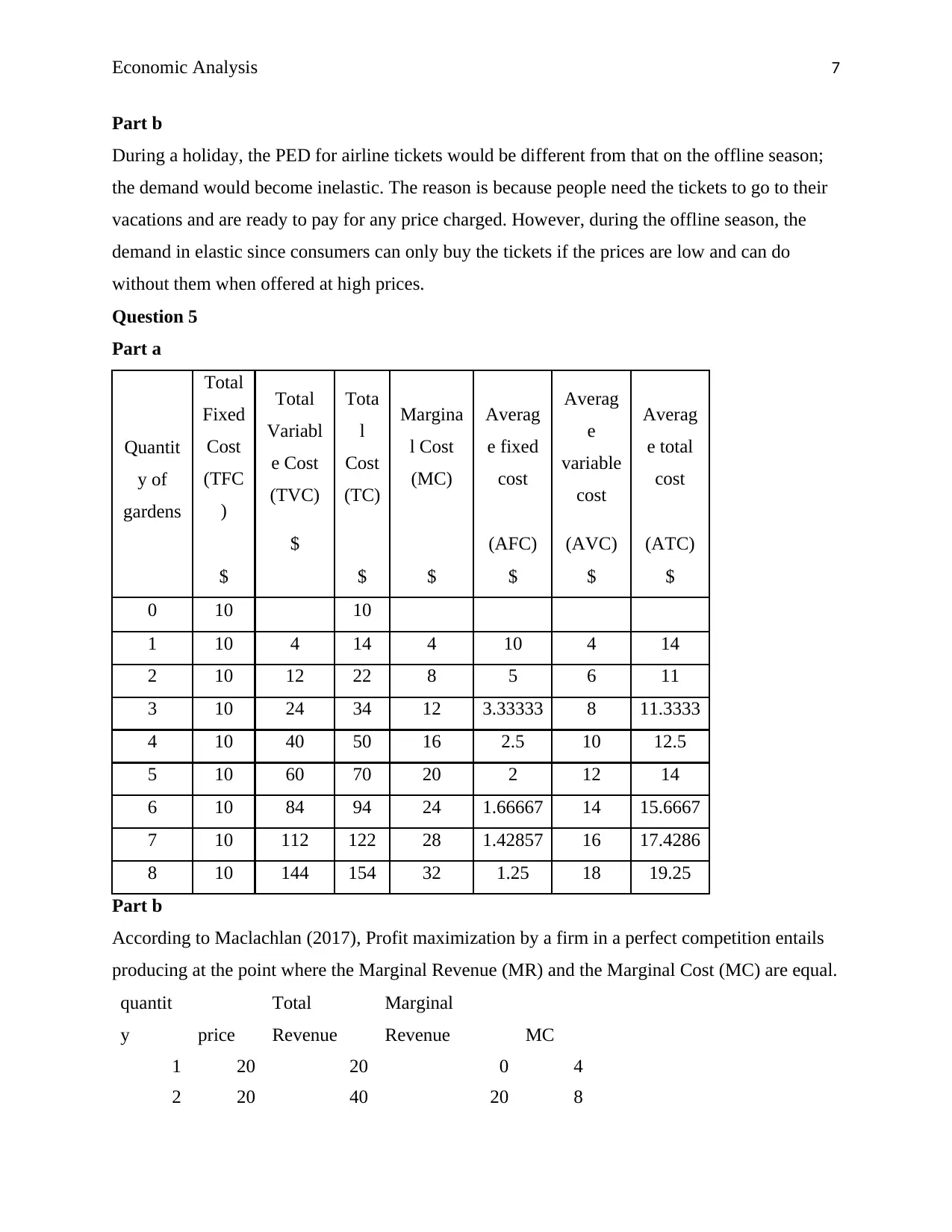
Economic Analysis 7
Part b
During a holiday, the PED for airline tickets would be different from that on the offline season;
the demand would become inelastic. The reason is because people need the tickets to go to their
vacations and are ready to pay for any price charged. However, during the offline season, the
demand in elastic since consumers can only buy the tickets if the prices are low and can do
without them when offered at high prices.
Question 5
Part a
Quantit
y of
gardens
Total
Fixed
Cost
(TFC
)
Total
Variabl
e Cost
(TVC)
Tota
l
Cost
(TC)
Margina
l Cost
(MC)
Averag
e fixed
cost
Averag
e
variable
cost
Averag
e total
cost
$ (AFC) (AVC) (ATC)
$ $ $ $ $ $
0 10 10
1 10 4 14 4 10 4 14
2 10 12 22 8 5 6 11
3 10 24 34 12 3.33333 8 11.3333
4 10 40 50 16 2.5 10 12.5
5 10 60 70 20 2 12 14
6 10 84 94 24 1.66667 14 15.6667
7 10 112 122 28 1.42857 16 17.4286
8 10 144 154 32 1.25 18 19.25
Part b
According to Maclachlan (2017), Profit maximization by a firm in a perfect competition entails
producing at the point where the Marginal Revenue (MR) and the Marginal Cost (MC) are equal.
quantit
y price
Total
Revenue
Marginal
Revenue MC
1 20 20 0 4
2 20 40 20 8
Part b
During a holiday, the PED for airline tickets would be different from that on the offline season;
the demand would become inelastic. The reason is because people need the tickets to go to their
vacations and are ready to pay for any price charged. However, during the offline season, the
demand in elastic since consumers can only buy the tickets if the prices are low and can do
without them when offered at high prices.
Question 5
Part a
Quantit
y of
gardens
Total
Fixed
Cost
(TFC
)
Total
Variabl
e Cost
(TVC)
Tota
l
Cost
(TC)
Margina
l Cost
(MC)
Averag
e fixed
cost
Averag
e
variable
cost
Averag
e total
cost
$ (AFC) (AVC) (ATC)
$ $ $ $ $ $
0 10 10
1 10 4 14 4 10 4 14
2 10 12 22 8 5 6 11
3 10 24 34 12 3.33333 8 11.3333
4 10 40 50 16 2.5 10 12.5
5 10 60 70 20 2 12 14
6 10 84 94 24 1.66667 14 15.6667
7 10 112 122 28 1.42857 16 17.4286
8 10 144 154 32 1.25 18 19.25
Part b
According to Maclachlan (2017), Profit maximization by a firm in a perfect competition entails
producing at the point where the Marginal Revenue (MR) and the Marginal Cost (MC) are equal.
quantit
y price
Total
Revenue
Marginal
Revenue MC
1 20 20 0 4
2 20 40 20 8
Paraphrase This Document
Need a fresh take? Get an instant paraphrase of this document with our AI Paraphraser
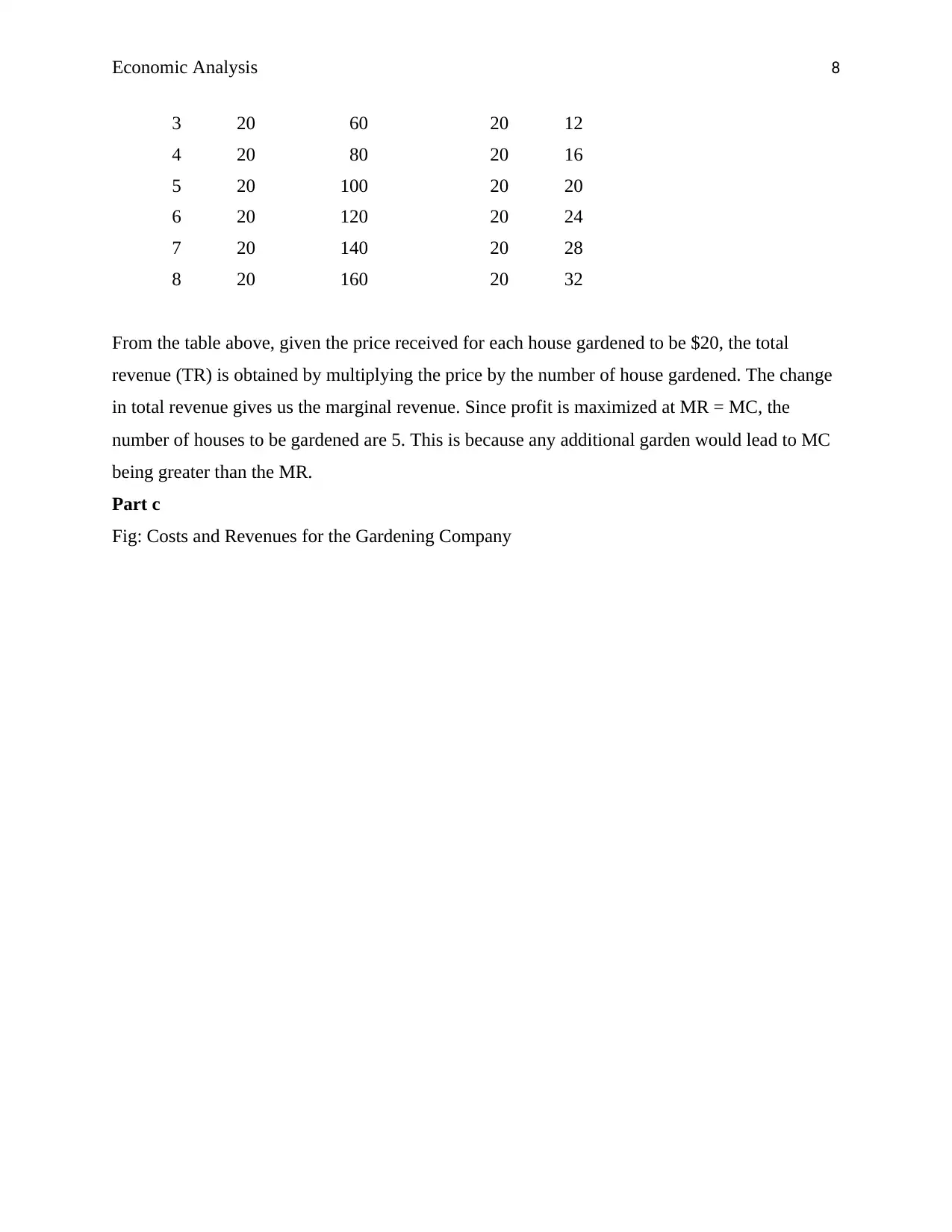
Economic Analysis 8
3 20 60 20 12
4 20 80 20 16
5 20 100 20 20
6 20 120 20 24
7 20 140 20 28
8 20 160 20 32
From the table above, given the price received for each house gardened to be $20, the total
revenue (TR) is obtained by multiplying the price by the number of house gardened. The change
in total revenue gives us the marginal revenue. Since profit is maximized at MR = MC, the
number of houses to be gardened are 5. This is because any additional garden would lead to MC
being greater than the MR.
Part c
Fig: Costs and Revenues for the Gardening Company
3 20 60 20 12
4 20 80 20 16
5 20 100 20 20
6 20 120 20 24
7 20 140 20 28
8 20 160 20 32
From the table above, given the price received for each house gardened to be $20, the total
revenue (TR) is obtained by multiplying the price by the number of house gardened. The change
in total revenue gives us the marginal revenue. Since profit is maximized at MR = MC, the
number of houses to be gardened are 5. This is because any additional garden would lead to MC
being greater than the MR.
Part c
Fig: Costs and Revenues for the Gardening Company
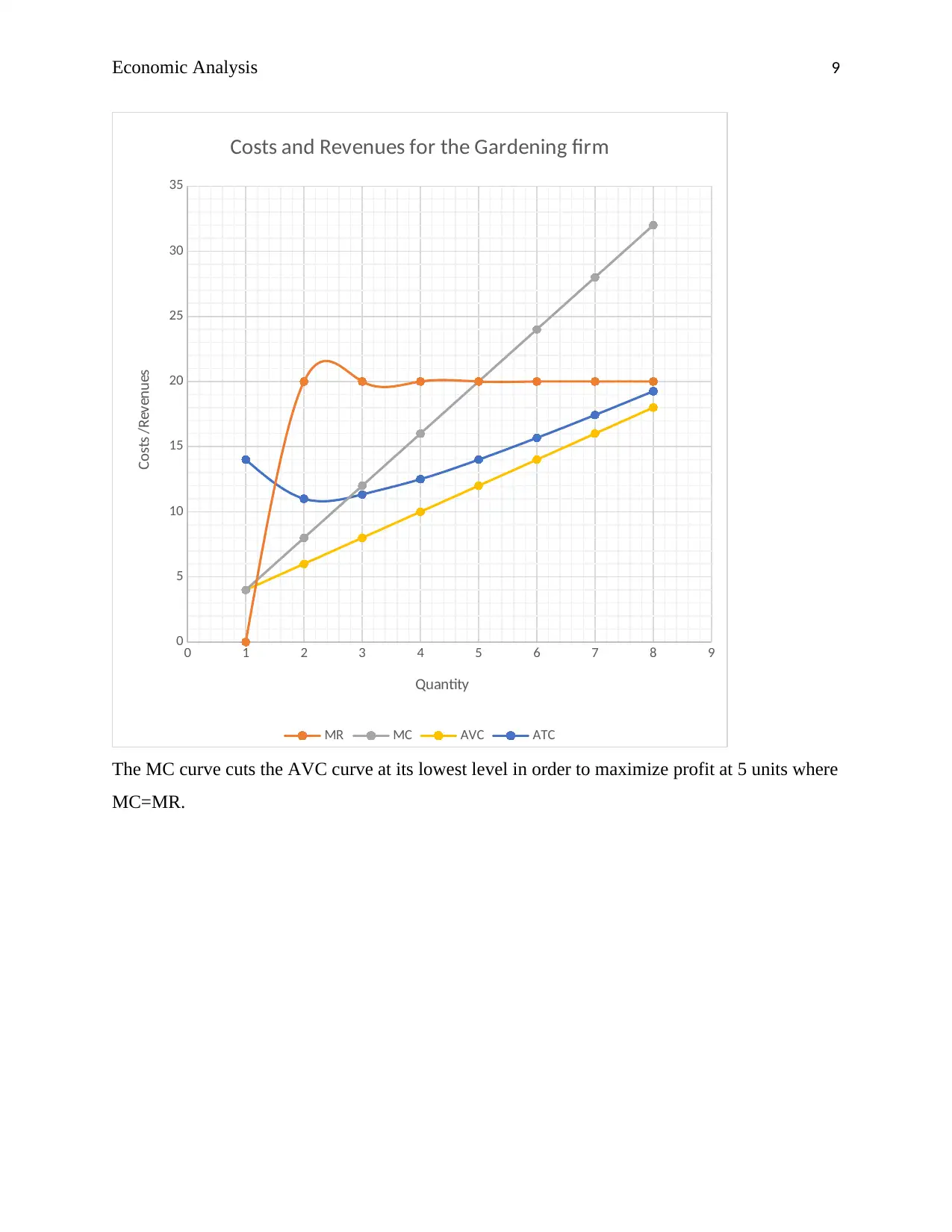
Economic Analysis 9
0 1 2 3 4 5 6 7 8 9
0
5
10
15
20
25
30
35
Costs and Revenues for the Gardening firm
MR MC AVC ATC
Quantity
Costs /Revenues
The MC curve cuts the AVC curve at its lowest level in order to maximize profit at 5 units where
MC=MR.
0 1 2 3 4 5 6 7 8 9
0
5
10
15
20
25
30
35
Costs and Revenues for the Gardening firm
MR MC AVC ATC
Quantity
Costs /Revenues
The MC curve cuts the AVC curve at its lowest level in order to maximize profit at 5 units where
MC=MR.
⊘ This is a preview!⊘
Do you want full access?
Subscribe today to unlock all pages.

Trusted by 1+ million students worldwide
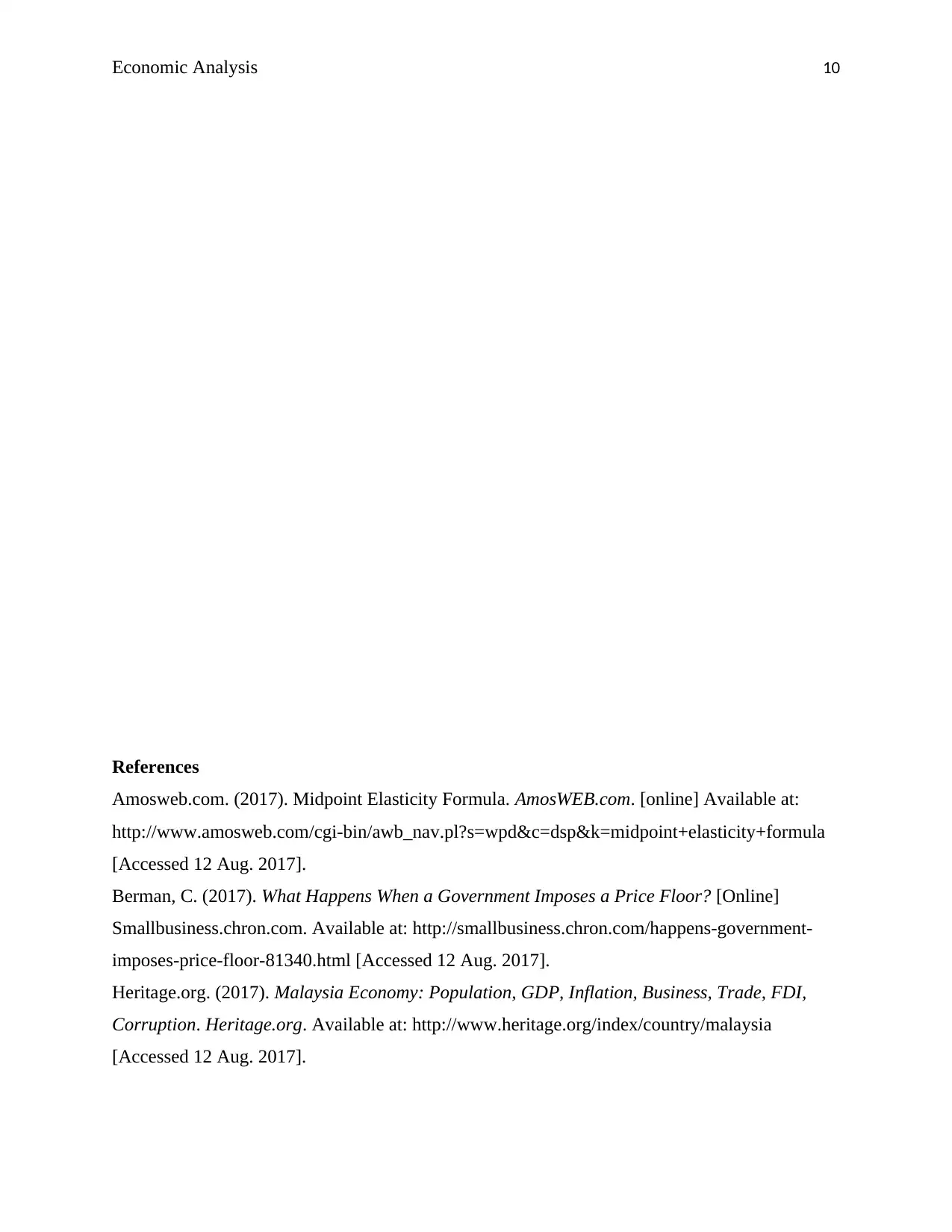
Economic Analysis 10
References
Amosweb.com. (2017). Midpoint Elasticity Formula. AmosWEB.com. [online] Available at:
http://www.amosweb.com/cgi-bin/awb_nav.pl?s=wpd&c=dsp&k=midpoint+elasticity+formula
[Accessed 12 Aug. 2017].
Berman, C. (2017). What Happens When a Government Imposes a Price Floor? [Online]
Smallbusiness.chron.com. Available at: http://smallbusiness.chron.com/happens-government-
imposes-price-floor-81340.html [Accessed 12 Aug. 2017].
Heritage.org. (2017). Malaysia Economy: Population, GDP, Inflation, Business, Trade, FDI,
Corruption. Heritage.org. Available at: http://www.heritage.org/index/country/malaysia
[Accessed 12 Aug. 2017].
References
Amosweb.com. (2017). Midpoint Elasticity Formula. AmosWEB.com. [online] Available at:
http://www.amosweb.com/cgi-bin/awb_nav.pl?s=wpd&c=dsp&k=midpoint+elasticity+formula
[Accessed 12 Aug. 2017].
Berman, C. (2017). What Happens When a Government Imposes a Price Floor? [Online]
Smallbusiness.chron.com. Available at: http://smallbusiness.chron.com/happens-government-
imposes-price-floor-81340.html [Accessed 12 Aug. 2017].
Heritage.org. (2017). Malaysia Economy: Population, GDP, Inflation, Business, Trade, FDI,
Corruption. Heritage.org. Available at: http://www.heritage.org/index/country/malaysia
[Accessed 12 Aug. 2017].
1 out of 10
Related Documents
Your All-in-One AI-Powered Toolkit for Academic Success.
+13062052269
info@desklib.com
Available 24*7 on WhatsApp / Email
![[object Object]](/_next/static/media/star-bottom.7253800d.svg)
Unlock your academic potential
Copyright © 2020–2025 A2Z Services. All Rights Reserved. Developed and managed by ZUCOL.





